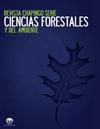墨西哥塔巴斯科洛斯里奥斯地区的植被覆盖和土地利用变化(1947-2019)
IF 0.6
4区 农林科学
Q3 Agricultural and Biological Sciences
Revista Chapingo Serie Ciencias Forestales Y Del Ambiente
Pub Date : 2022-08-30
DOI:10.5154/r.rchscfa.2022.01.001
引用次数: 0
摘要
引言:农业用途的扩大导致植被覆盖的变化、生物多样性和生态系统服务的丧失。目的:分析1947-2019年墨西哥塔巴斯科洛斯里奥斯地区土地利用变化及其对自然植被的影响。材料和方法:使用1947年的航空照片和卫星图像的监督分类,共确定了14个土地利用和植被类别,用出版的制图和2019年(陆地卫星8号)在实地进行了验证。通过将地图与TerrSet程序中集成的土地变化建模器模块进行叠加和比较,分析了土地利用和植被覆盖的变化。结果与讨论:72年来,自然植被大多被农作物、草地和森林取代,其次是人类住区。这些用途加起来占该地区表面的14.2%,增加到61.8%;即增长435%。这些用途取代了雨林、次生植被和水生植物的覆盖率,从82.3%上升到29.7%,相当于这些覆盖率的64%。1947年至1984年间,自然植被面积损失最大(53.7%)。结论:该地区自然植被的丧失是由于农业用地和人类住区的增加。农业用地的增加是由政府计划推动的,没有考虑环境因素。本文章由计算机程序翻译,如有差异,请以英文原文为准。
Vegetation cover and land use change (1947-2019) in the region of Los Ríos, Tabasco, México
Introduction: The spread of agricultural use leads to changes in vegetation cover, loss of biodiversity and ecosystem services. Objective: To analyze land use change and its effect on natural vegetation in the region of Los Ríos, Tabasco, Mexico, during the period 1947-2019. Materials and methods: A total of 14 land use and vegetation classes were identified using aerial photographs from 1947 and supervised classification of satellite images, verifying those from 1947 to 2000 with published cartography and those from 2019 (Landsat 8) in the field. Land use and vegetation cover change was analyzed by overlaying and comparing the maps with the Land Change Modeler module integrated in the TerrSet program. Results and discussion: In 72 years, natural vegetation was mostly replaced by crops, grassland and forest plantations, followed by human settlements. These uses, together, represented 14.2 % of the region’s surface and increased to 61.8 %; that is, an increase of 435 %. These uses replaced areas of rainforest, secondary vegetation and hydrophytes, which went from 82.3 % to 29.7 %, representing a loss of 64 % of these coverages. Between 1947 and 1984, natural vegetation suffered the greatest loss of area (53.7 %). Conclusions: The loss of natural vegetation in the region occurred because of the increase in agricultural land and human settlements. The increase in agricultural land was driven by government programs without considering the environmental factor.
求助全文
通过发布文献求助,成功后即可免费获取论文全文。
去求助
来源期刊
CiteScore
1.20
自引率
16.70%
发文量
0
审稿时长
>12 weeks
期刊介绍:
The Revista Chapingo Serie Ciencias Forestales y del Ambiente (RCHSCFA) is a scientific journal that aims to raise awareness of high-quality research products related to forest, arid, temperate and tropical environments in the world. Since its foundation in 1994, the RCHSCFA has served as a space for scientific dissemination and discussion at a national and international level among academics, researchers, undergraduate and graduate students, forest managers and public/private entities that are interested in the forest environment.
All content published in the journal first goes through a strict triple-blind review process and is published in the following formats: Scientific Articles, Review Articles, Methodologies, Technical or Technological Notes.

 求助内容:
求助内容: 应助结果提醒方式:
应助结果提醒方式:


